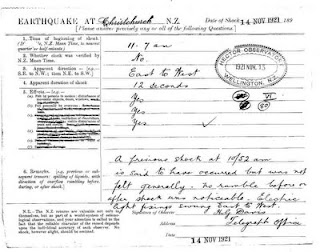When you go to the GeoNet homepage you will see a map of NZ covered in small squares, this is 'ShakeNZ'. Each one of the squares gets near real-time shaking (this means in a few minutes, not right away) from our instruments out in the field. So within a few minutes of an earthquake, you can look at the map and get a rough idea of where it was and the intensity of the shaking.

The key thing here is actually to do with the key! The pic on the right is the key for the map, which shows intensity,
not magnitude! So when there is an earthquake and you can see an area of coloured squares, they are showing the intensity of shaking not the size.
The numbers correspond to the
Modified Mercalli Intensity Scale, this is a really handy way to describe the effects of an earthquake, and is generally better than using the magnitude alone (as a mag 4 quake at 5km depth will produce a higher shaking intensity than a mag 4 at 10km depth) It goes from MM 1 (barely felt by a few people) to MM 12 (complete devastation).
<--- This is what the map looks like with no activity, small blue/purple squares (blank = no data)
This is the map after a mag 5.5 earthquake, 30km deep near Wellington. -->

Now occasionally when we have technical issues ( the instrument is having a bad day, or a tech is out fixing something) there will be a 'rogue' square! Its usually pretty easy to see that its an error and not a large earthquake as there is just one square showing a high intensity, and when there is an actual event multiple squares will be 'lit up' .
The map on the left shows one station/square showing an orange square, or 7 intensity of shaking, if this was an actual event the squares close by would also show some level of intensity. There are more examples
here.
You can also use an interactive version
here and go from 60min to the present - a cool way at looking at the squares light up following an earthquake.












